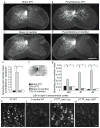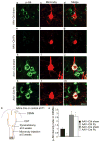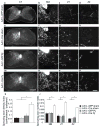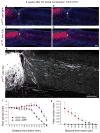PTEN deletion enhances the regenerative ability of adult corticospinal neurons
- PMID: 20694004
- PMCID: PMC2928871
- DOI: 10.1038/nn.2603
PTEN deletion enhances the regenerative ability of adult corticospinal neurons
Abstract
Despite the essential role of the corticospinal tract (CST) in controlling voluntary movements, successful regeneration of large numbers of injured CST axons beyond a spinal cord lesion has never been achieved. We found that PTEN/mTOR are critical for controlling the regenerative capacity of mouse corticospinal neurons. After development, the regrowth potential of CST axons was lost and this was accompanied by a downregulation of mTOR activity in corticospinal neurons. Axonal injury further diminished neuronal mTOR activity in these neurons. Forced upregulation of mTOR activity in corticospinal neurons by conditional deletion of Pten, a negative regulator of mTOR, enhanced compensatory sprouting of uninjured CST axons and enabled successful regeneration of a cohort of injured CST axons past a spinal cord lesion. Furthermore, these regenerating CST axons possessed the ability to reform synapses in spinal segments distal to the injury. Thus, modulating neuronal intrinsic PTEN/mTOR activity represents a potential therapeutic strategy for promoting axon regeneration and functional repair after adult spinal cord injury.
Figures







Similar articles
-
Pten Deletion Promotes Regrowth of Corticospinal Tract Axons 1 Year after Spinal Cord Injury.J Neurosci. 2015 Jul 1;35(26):9754-63. doi: 10.1523/JNEUROSCI.3637-14.2015. J Neurosci. 2015. PMID: 26134657 Free PMC article.
-
Modulation of Both Intrinsic and Extrinsic Factors Additively Promotes Rewiring of Corticospinal Circuits after Spinal Cord Injury.J Neurosci. 2021 Dec 15;41(50):10247-10260. doi: 10.1523/JNEUROSCI.2649-20.2021. Epub 2021 Nov 10. J Neurosci. 2021. PMID: 34759029 Free PMC article.
-
Short hairpin RNA against PTEN enhances regenerative growth of corticospinal tract axons after spinal cord injury.J Neurosci. 2013 Sep 25;33(39):15350-61. doi: 10.1523/JNEUROSCI.2510-13.2013. J Neurosci. 2013. PMID: 24068802 Free PMC article.
-
Intrinsic regulation of axon regeneration after spinal cord injury: Recent advances and remaining challenges.Exp Neurol. 2022 Nov;357:114198. doi: 10.1016/j.expneurol.2022.114198. Epub 2022 Aug 6. Exp Neurol. 2022. PMID: 35944658 Review.
-
PTEN/mTOR and axon regeneration.Exp Neurol. 2010 May;223(1):45-50. doi: 10.1016/j.expneurol.2009.12.032. Epub 2010 Jan 14. Exp Neurol. 2010. PMID: 20079353 Review.
Cited by
-
Plasticity of intact rubral projections mediates spontaneous recovery of function after corticospinal tract injury.J Neurosci. 2015 Jan 28;35(4):1443-57. doi: 10.1523/JNEUROSCI.3713-14.2015. J Neurosci. 2015. PMID: 25632122 Free PMC article.
-
Respiratory axon regeneration in the chronically injured spinal cord.Neurobiol Dis. 2021 Jul;155:105389. doi: 10.1016/j.nbd.2021.105389. Epub 2021 May 8. Neurobiol Dis. 2021. PMID: 33975016 Free PMC article.
-
Axonal outgrowth and dendritic plasticity in the cortical peri-infarct area after experimental stroke.Stroke. 2012 Aug;43(8):2221-8. doi: 10.1161/STROKEAHA.111.646224. Epub 2012 May 22. Stroke. 2012. PMID: 22618383 Free PMC article.
-
Transcriptional repression of PTEN in neural cells using CRISPR/dCas9 epigenetic editing.Sci Rep. 2020 Jul 9;10(1):11393. doi: 10.1038/s41598-020-68257-y. Sci Rep. 2020. PMID: 32647121 Free PMC article.
-
Intrathecal delivery of IL-6 reactivates the intrinsic growth capacity of pyramidal cells in the sensorimotor cortex after spinal cord injury.PLoS One. 2015 May 19;10(5):e0127772. doi: 10.1371/journal.pone.0127772. eCollection 2015. PLoS One. 2015. PMID: 25992975 Free PMC article.
References
-
- Raineteau O, Schwab ME. Plasticity of motor systems after incomplete spinal cord injury. Nat Rev Neurosci. 2001;2:263–273. - PubMed
-
- Blesch A, Tuszynski MH. Spinal cord injury: plasticity, regeneration and the challenge of translational drug development. Trends Neurosci. 2009;32:41–47. - PubMed
-
- Zheng B, Lee JK, Xie F. Genetic mouse models for studying inhibitors of spinal axon regeneration. Trends Neurosci. 2006;29:640–646. - PubMed
-
- Deumens R, Koopmans GC, Joosten EA. Regeneration of descending axon tracts after spinal cord injury. Prog Neurobiol. 2005;77:57–89. - PubMed
-
- Thallmair M, Metz GA, Z’Graggen WJ, Raineteau O, Kartje GL, Schwab ME. Neurite growth inhibitors restrict plasticity and functional recovery following corticospinal tract lesions. Nat Neurosci. 1998;1:124–31. - PubMed
Publication types
MeSH terms
Substances
Grants and funding
LinkOut - more resources
Full Text Sources
Other Literature Sources
Molecular Biology Databases
Research Materials
Miscellaneous

